Types of California Palm Trees With Identification (Pictures & Names)

Palm trees are a common sight in the California skyline. Tall, majestic palms with crowns of arching fronds look spectacular against beautiful sunsets along the coast of the Golden State. From the native California palm tree to king palms, slender Mexican fan palms, kentia palms, and date palms, it seems that palm trees are prevalent throughout the state of California.
Most California palm trees grow along the coastline and inland areas close to the Pacific Ocean in USDA zones 9 to 11. Most species of palms thrive in the year-long sunshine and warmth of the southwest. However, some cold-hardy varieties of palms, like the jelly palm, can survive in zone 8, where the temperatures can dip below freezing.
The article is a guide to many types of palm trees that commonly grow in California. In addition, you will learn about the native California fan palm and other palms that thrive in California.
Are Palm Trees Native to California?
Most palm trees need plenty of direct sunlight to thrive, and the warm climate in California provides the perfect conditions. Native palms in California are ones that occur naturally and haven’t been introduced. And although there is only one native California palm, many other species of palms thrive without becoming invasive.
What Are Native California Palm Trees?
The California fan palm (Washingtonia filifera) or California palm is the only species of palm tree native to California. This majestic palm, with its robust columnar trunks, grows naturally in the Mojave Desert and the Colorado Desert. However, many other species of palm trees that grow in California have been introduced.
The most common types of palm trees in California are not native palms. Lining the streets of Malibu, San Jose, San Francisco, and Santa Cruz are tropical palms like Mexican fan palms, Canary Island date palms, King Palms, and Pindo Palms. Many species of dwarf palms are also ideal for residential California landscapes.
Los Angeles Palm Trees
The streets of Los Angeles—from Beverly Hills to the base of the San Gabriel—are famous for tall, slender palm trees, topped with rounded crowns of feather-like arching fronds. Most Los Angeles palms are Mexican fan palms (Washingtonia robusta) that were introduced by Spanish missionaries.
Types of California Palm Trees
California is home to a variety of palm trees, from the native California fan palm to more exotic varieties. These tropical palms thrive in the warm climate of the Golden State and line many of the streets in cities and towns.
California Fan Palm (Washingtonia filifera)
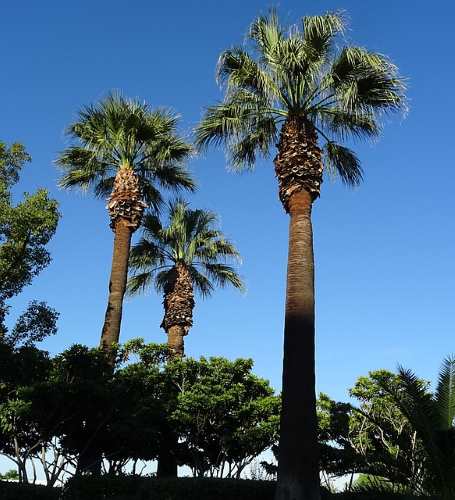
The tall California fan palm is identified by its fan shaped fronds and is the only native palm to California
The California fan palm is the only native palm in the Western United States. The native California palm palm is identified by its beautiful fan-shaped fronds of waxy gray-green blades. This impressive palm tree has arching leaves 3 to 6 ft. (1 – 1.8 m) long and huge sprays of white tubular flowers up to 15 ft. (5 m) long.
An identifying feature of the California palm is the large shaggy growth of brown dead leaves forming a grass skirt under the crown. Also called the desert fan palm or petticoat palm, this native palm tree grows 40 to 60 ft. (12 – 18 m) tall with a crown 10 to 20 ft. (3 – 6 m) wide.
This upright, erect palm is one of the cold-hardiest palms in California and thrives in USDA zones 8 to 11. It is also the largest native palm tree in North America.
Additionally, the tall California fan palm has a moderate growth rate, averaging about 1.5 ft. (0.5 m) per year. However, the native palm typically grows slower in residential landscapes, making it an ideal landscaping palm tree for medium to large-sized gardens.
California Palm Tree Identification: The California fan palm is the only palm native to California. It has an easily recognizable “petticoat” of dead leaves below its arching crown.
King Palm (Archontophoenix alexandrae)
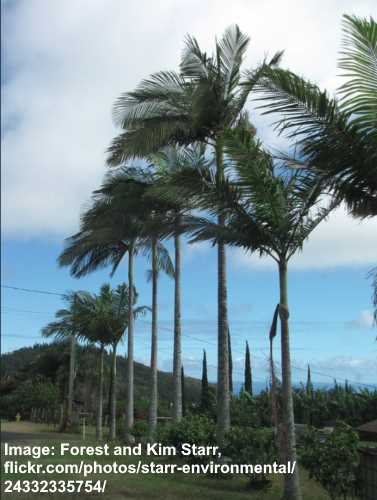
Alexandra palm is a tall tree with a slender trunk suitable for the warm California climate
The king palm tree is a single-stemmed, tall, slender palm tree with a straight gray trunk and crown of feather-like fronds. The leaves of the king palm are up to 4.5 ft. (15 m) long with 60 to 80 leaflets. The flowering palm tree has clusters of white flowers followed by bright red palm fruits growing on stems 1.5 to 3.3 ft. (0.5 – 1 m) long.
The king palm is native to Australia and grows up to 100 ft. (30 m) tall with a trunk 1 ft. (0.3 m) in diameter and a spreading crown spread of 15 ft. (3 – 4.5 m). Another identifying feature of the king palm is its smooth lime-green crown shaft.
California Palm Tree Identification: The tall palm tree has upright growth with slim trunk and a bright green smooth crown shaft with arching fronds.
Mexican Fan Palm (Washingtonia robusta)
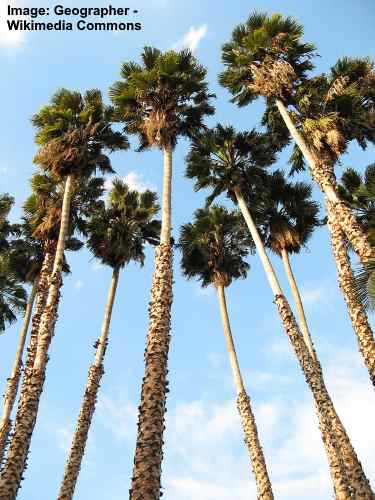
The Mexican fan palm tree has tall and skinny trunk and is common in California
The Mexican fan palm is one of the most common palm trees you will see in California. The Mexican fan palm is a tall, single-stemmed, fast-growing palm tree with a slender, columnar trunk crowned with fan-shaped palmate fronds. Other characteristics of the palm are the swollen base at the trunk, huge 10-foot (3 m) sprays of white flowers, and black, pea-sized fruits.
The Mexican fan palm grows up to 40 to 80 ft. (12 – 24 m) tall with a small rounded crown 8 to 10 ft. (2.4 – 3 m) wide. Like the native California fan palm, dead fronds on the Mexican palm form a dense skirt at the top of the trunk.
Despite its popularity in California, the Mexican fan palm is non-native and is considered invasive in some areas.
California Palm Tree Identification: The Mexican fan palm has a slender trunk, a small, rounded crown, and a skirt-like growth around the crown shaft.
Kentia Palm (Howea forsteriana)

Kentia palm is a slow growing ornamental tree that is popular in California
The Kentia palm is a slow-growing non-native palm tree that commonly grows in California. The elegant and stately palm tree has arching, feather-like, deep green leaves measuring 12 ft. (3.7 m) long. The huge fronds have finger-like, pointed leaflets drooping from the central petiole, giving the palm a graceful appearance.
The Kentia palm makes for a captivating ornamental feature in any garden or for lining a street. These cold-hardy, tropical palms grow 20 to 60 ft. (6 – 18 m) tall. Other characteristics of the palm are its white flowers that give way to red egg-shaped palm fruits.
The Kentia palm is one of the most popular indoor potted palm trees that tolerate shade and low light. Find out how to care for indoor palm plants.
California Palm Tree Identification: The Kentia palm tree has arching fronds with leaflets creating a V shape.
Date Palm (Phoenix dactylifera)
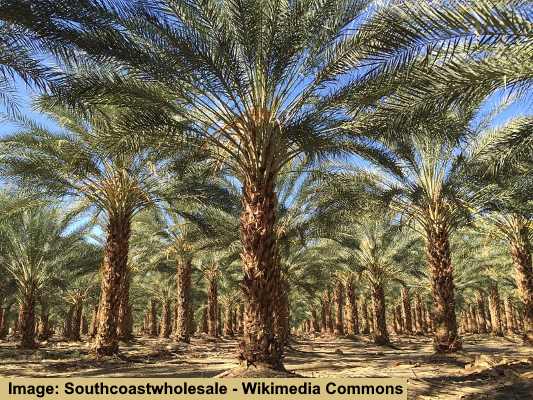
Date palm trees grow in the coastal areas of California and produce delicious fruit
The date palm is easily recognizable by its upward-growing, arching, feather-like fronds and enormous clusters of red fruits. These date-producing palms have slender trunks with a shaggy appearance, fronds measuring 10 to 16 ft. (3 – 5 m) long, creamy-yellow flowers, and clusters of sweet edible fruits.
With its distinctly exotic look, the beautiful date palm tree thrives in coastal regions in USDA zones 9 to 11. Date palms grow 50 to 80 ft. (15 – 24 m) tall with a huge crown 20 to 40 ft. (6 – 12 m) wide.
This type of palm is sometimes confused with the Canary Island date palm (Phoenix canariensis)—a small and more ornamental palm variety for California gardens.
The date palm tree is a tropical palm that thrives in Texas and other southern states.
California Palm Tree Identification: The date palm is easily identified due to its arching fronds and massive clusters of edible dates.
Florida Royal Palm (Roystonea regia)
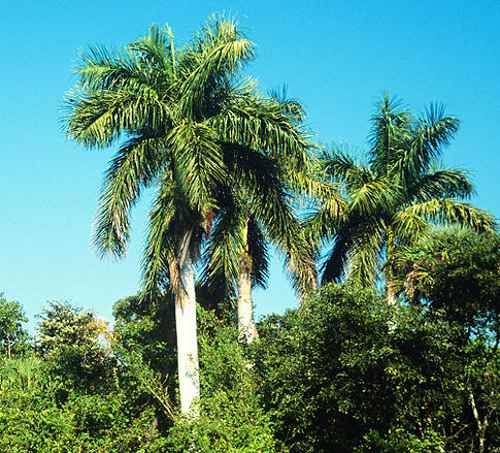
The Florida royal palm lines streets in California and is identified by a smooth erect pale trunk and bushy crown
The Florida royal palm is an impressive palm tree characterized by a smooth, silvery-gray trunk, bright green crown shaft, and large feathery fronds. The huge palm leaves can grow 10 to 15 ft. (3 – 4.5 m) long and weigh up to 50 lbs. (22.5 kg). The abundant clusters of tiny white flowers bloom, followed by dark red to black edible fruits.
The tall and elegant Florida royal palm tree grows 60 to 100 ft. (18 – 30 m) tall. Its crown of 15 gracefully arching fronds forms a rounded crown measuring 20 to 30 ft. (6 – 9 m) across. The tall, upright palms are typically used to line streets in southern states.
California Palm Tree Identification: The identifying features of the Florida palm are its arching fronds, bright green crown shaft, and slender appearance.
Queen Palm (Syagrus romanzoffiana)
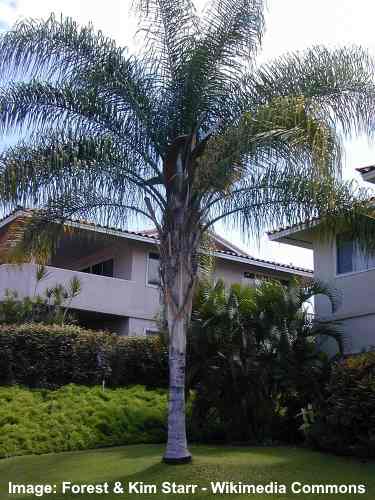
The queen palm is a popular ornamental fast growing tree in California
The queen palm is a popular ornamental palm tree in California and other warm climates. The evergreen palm tree is characterized by its single slender ringed trunk, clusters of creamy-white flowers, and hanging bunches of yellow to orange edible fruits. The upright palm is ideal as a specimen or street tree.
The beautiful queen palm tree grows 50 to 70 ft. (15 – 21 m) tall with a spread of 20 to 30 ft. (6 – 9 m). It thrives in USDA zones 9 to 11, with a fast growth rate of 2 ft. (0.6 m) per year.
California Palm Tree Identification: The open, spreading crown of curved feather-like fronds and smooth, ringed trunk are the queen palm’s identifying features.
Bismarck Palm (Bismarckia nobilis)

Bismarck palm tree has beautiful silvery gray foliage and is cold sensitive and slow grower
The Bismarck palm is one of the most stunning ornamental palm trees for a California garden landscape. This short palm is identified by its huge fan-shaped fronds, bluish-green or steely-blue color, and single stout trunk. This easy-to-care-for decorative tree adds bold color and texture to any landscape in warm climates.
The Bismarck palm is a slow-growing tree that grows 40 to 70 ft. (12 – 21 m) tall. Its crown is formed by stiff fan-shaped leaves that grow in all directions creating a spherical crown with a spread of 10 to 15 ft. (3 – 4.5 m). It grows best in USDA zones 10 and 11 and requires full sun for optimal growth
The Bismarck palm is also on the list of native palm trees that thrive in Florida.
California Palm Tree Identification: The Bismarck palm has a solitary, robust trunk with large fan-shaped gray-silver stiff leaves.
San Jose Hesper Palm (Brahea brandegeei)

San Jose hesper palm is a heat loving tree suitable for arid climates
The San Jose Hesper palm tree is native to Baja California and has an elegant, slender trunk and dense crown. The identifying features of this southern palm tree are the spiky leaf bases covering the upright trunk, 3-foot (1 m) long feather-like fronds, and short flower stalks.
This slow-growing, heat-loving palm tree is drought-tolerant and ideally suited to arid climates. The San Jose Hesper palm grows 40 to 60 ft. (12 – 18 m) tall. Its tolerance to drought and hot temperatures make it an ideal palm tree for growing in arid landscapes.
California Palm Tree Identification: The San Jose Hesper palm has a rough, upward erect trunk with a characteristic crown of arching feather-like leaves.
Canary Island Date Palm (Phoenix canariensis)
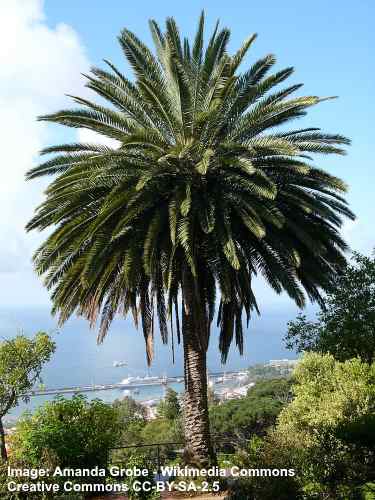
The beautiful Canary Island palm tree is popular in California and can be commonly seen along the beaches
The Canary Island date palm is a popular specimen palm, accent plant, or street tree in California. This commonly growing palm tree has a large “pineapple-like” canopy on top of a thick, stout trunk. The rounded crown has around 100 feather-like fronds measuring 15 ft. (4.5 m) long, forming a graceful arching shape.
Despite being a non-native palm in California, the Canary Island date palm is one of the state’s most recognizable palm trees. It grows 40 to 60 ft. (12 – 18 m) tall with a huge, spreading crown 40 ft. (12 m) wide. Its tolerance of salty air means it’s a popular palm tree to line California’s stunning beaches.
The Canary Island date palm is also an ideal container palm tree to grow in compact southern gardens.
California Palm Tree Identification: The identifying feature of the Canary Island palm tree is the thick growth just below the crown with recognizable diamond patterns.
Pindo Palm or Jelly Palm (Butia odorata)
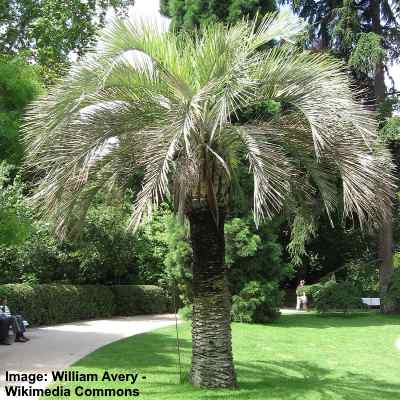
Pindo palm tree is a slow growing, cold-hardy and small palm tree variety. It’s an excellent palm tree for residential landscapes
The jelly palm or pindo palm is a small, slow-growing palm tree with arching feather-like fronds that curve to the ground. The cold-hardy palm tree is characterized by its dense crown of light green to bluish-green leaves 5 to 10 ft. (1.5 – 3 m) long. The date-producing palm has clusters of small flowers that are reddish-orange, purple, or greenish-yellow, followed by edible orange fruits.
The small jelly palm tree grows 12 to 15 ft. (3.6 – 4.5 m) tall. In smaller species, the tips of the arching leaves almost touch the ground, covering the pineapple-like stem.
California Palm Tree Identification: The dwarf jelly palm has curving feather-like fronds that create a bushy appearance.
Mediterranean Fan Palm (Chamaerops humilis)

he Mediterranean fan palm has few trunks and is small enough to suit many California gardens
The Mediterranean fan palm is a cold-hardy palm tree that thrives throughout California. The multi-stemmed clumping palm has fan-shaped leaves in a silver-green or blue-green color. The stiff pointed leaflets fan out to create an attractive spiky crown on this low-growing palm tree.
Also called the European fan palm tree, this shrub-like palm grows 6 to 15 ft. (1.8 – 4.5 m) tall. In addition to fan-shaped leaves growing on spiny petioles, the ornamental palm has short clusters of bright yellow flowers that ripen to brown fruits in the fall.
As one of the most versatile palm trees, the Mediterranean palm tolerates extreme heat, cold, and drought and thrives in full sun in USDA zones 9 to 11.
California Palm Tree Identification: Mediterranean palms are small multi trunked trees with silver-green fan-shaped leaves.
Beach Palm (Allagoptera arenaria)
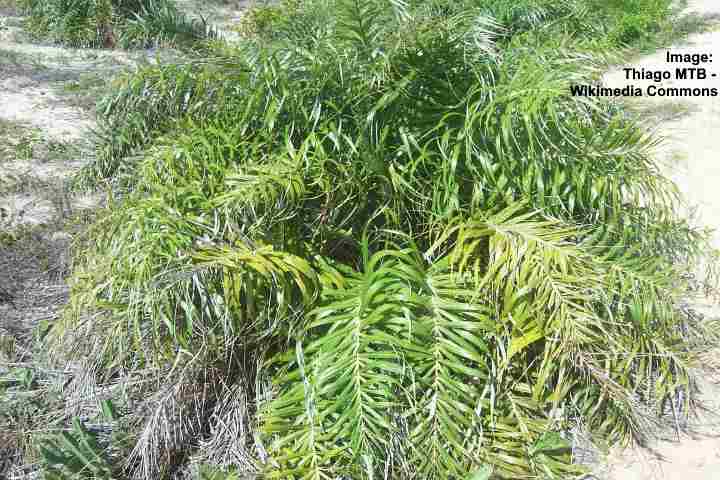
Beach palm s a short tree with leaves that emerge out of the ground from a trunk that is usually invisible
Also called the seashore palm, this beach palm tree grows well in sandy soil and tolerates salty air from the Pacific Ocean. This shrubby palm has leaves that grow from an underground trunk straight out of the ground. Shiny, deep-green lance-shaped curling leaflets cover the long petioles. The small palms grow up to 6 ft. (1.8 m) tall.
An unusual feature of the beach palm is the flowers that look like yellow corn-cobs on a long stick. The multi-branching palm grows more as a shrub than a palm tree. It’s a drought-tolerant, heat-loving shrub-like palm that grows in inland Southern California landscapes, coastal regions, and beach gardens.
California Palm Tree Identification: The identification features of the beach palm are its smooth, linear curled leaves and yellow cylindrical flowers.
Dwarf Sugar Palm (Arenga engleri)
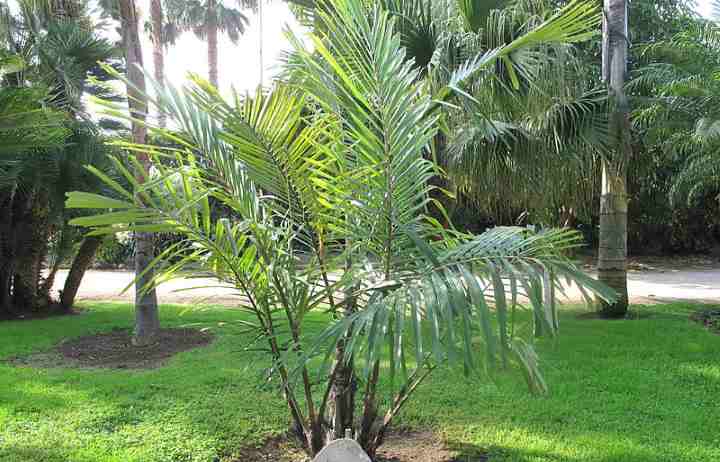
The dwarf sugar palm adds a decorative touch to small California garden landscapes
If you are looking for a small palm tree to landscape a California garden, then the dwarf sugar palm is an ideal choice. This low-growing, shrub-forming palm has arching feather-like fronds growing directly from the ground. The small landscaping palm shrub grows 8 ft. (2.4 m) tall and up to 16 ft. (5 m) wide.
Due to its versatility, the dwarf sugar palm tree has many uses in a southwestern garden landscape. For example, you can use the fern-like palm plant as a specimen plant, hedge plant, evergreen privacy screen, or in a container garden.
California Palm Tree Identification: The dwarf sugar palm has several feather-like leaves growing from the ground, fragrant yellow to orange blossoms, and spherical red fruits.
Flame Thrower Palm (Chambeyronia macrocarpa)
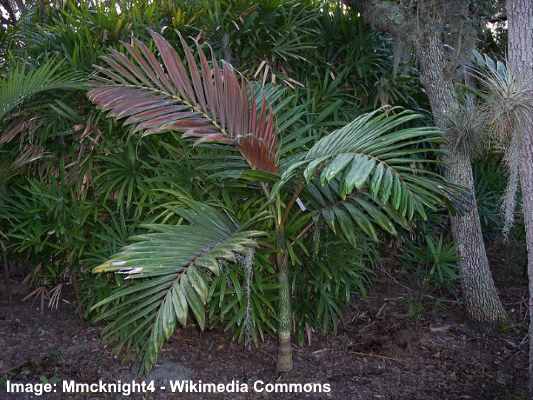
A young tree of flame thrower palm with reddish newly emerged leaf
The flame thrower palm tree is a single-stemmed palm with feather-like pinnate palm leaves, a bright green crown shaft, and clusters of small purple flowers, followed by bright red fruits. The unusual feature of this tropical palm tree is the newly emerged leaf that is red to maroon—hence the name “flame thrower” palm.
This slow-growing palm tree grows 20 to 25 ft. (6 – 7.6 m) tall with a crown 20 ft. (6 m) wide. In Southern California, the palm tree grows best in partial shade. However, the rare palm tree thrives in full sun in coastal areas along the Pacific Ocean.
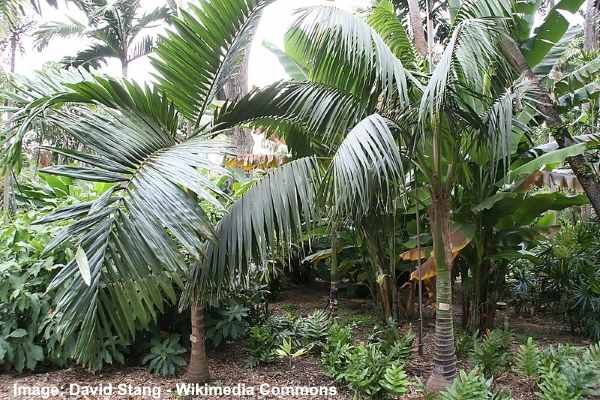
Mature trees of flame thrower palms
The unusual red leaf that emerges keeps its red color for 10 to 14 days before slowly turning green. Another feature of this palm tree is the grayish rings around a smooth green trunk.
California Palm Tree Identification: The easily identifiable feature of the flame thrower palm is its emerging red to deep red feather-like leaf.
Related articles:
